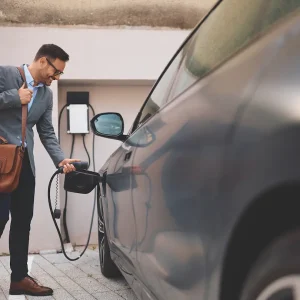
“I would say that insurance policies have gone up about 30% over the last few years, and if you’ve got a high proportion of EVs, you’ve got another 30% premium on there,” says AFP chair, Paul Hollick.
“Pre-Covid… average accident costs would probably be about £1,200 and the average VOR [vehicle-off-road time] would probably be about eight or nine days. Since Covid, you could pretty much double those for ICE vehicles and EVs are probably at least 30 days.”
The cost of electric car insurance is no secret, and arguably among operators’ biggest hurdles as fleets continue to prop up the UK EV market. Hefty premiums have led many to self-insure – covering vehicles on a third-party-only basis and handling repairs themselves – or to increase their policy excess.
In its 2023 report ‘Impact of BEV Adoption on the Repair and Insurance Sectors’, safety body Thatcham (which we approached for comment, but it did not respond) said BEV claims were 25.5% more expensive than those of ICEs and repairs took 14% longer. Many in the industry agree that insurers are generally quicker to write-off EVs than ICEs, too.
Underlying factors
It is easy to point the finger at insurers and, ultimately, they do set the premiums. But like anything – particularly EVs, which are misinformation magnets – there is more to this than headline figures. One source told us that most insurance companies do not make a profit on motor fleet policies, irrespective of what powers the vehicles. Equally, fleets are largely responsible for the growth in EVs, which means their insurers are more exposed to them.
“Seventy to eighty per cent of EVs are going into company car and salary sacrifice schemes,” explains Jon Dye, director of underwriting for motor at QBE, “so commercial insurers are seeing the transition quicker than in the retail market.”
“Insurers are trying to underwrite a very immature product in an immature market,” adds Dave Parry, commercial director at accident management specialist FMG, “it’s gone from being niche to mainstream overnight.
“EVs are still a relatively small proportion of the repairs the industry sees… in the fleet sector this year, about 30% of all our repairs will be BEVs. Five years ago, it was 3%.”
Insurers like clear historical data and they have that with petrol and diesel cars. EVs may have mushroomed in fleet but they have not been around for long enough to generate the same demonstrable risk profile. As one source told us, “The cultures of the traditional insurers are that they don’t like change – they’ve never liked change, and even when there is change, they only find comfort if they’ve got historic data.”
Material question
Then there is the cost and technology of the vehicles. Put simply, they are more advanced, so the components are pricier – and not just the powertrains.
Parry continues: “We’ve got a lot more carbon now and a lot more plastics to try and balance the weight distribution of the vehicle, because the batteries are so heavy.”
“I’m stressing the point to make one, but 20 years ago, you’d have a hammer and a dolly to knock out damage. Those days are long gone, because there’s lots of composite material now. We might need three different welders on one repair, because there might be some aluminium, and you might need plastic welders. More skills are required because more methods are required.”
Those skills are not exactly in abundance, either, which adds to the time and expense of getting EVs through workshops. In August, the Institute of the Motor Industry said there were 58,800 technicians qualified to work on EVs, representing 24% of the workforce. Based on the forecast increase in EVs on UK roads, the organisation predicted a shortfall of 3,000 technicians by 2031 and 16,000 by 2035.
Any accident in which an EV’s battery is damaged is highly likely to result in an insurance write-off on cost and safety grounds. Thatcham’s report claimed the average price of a replacement battery was £18,160, which was enough to outweigh the average used vehicle value by the time a car was a year old (£16,943, according to the report). That excludes the average cost of the repair itself, which was said to range from £1,553 to £563 for a one-to-five-year-old car, a flat £1,800 for hire costs to cover VOR time, and a flat £500 for “extra cost[s] associated with BEV”.
Battery packs are typically located at the bottom of the car, rendering them vulnerable to a clout from below (think speedbump or a steep-angled car park entrance) and, even if the powertrain survives an incident unscathed, there are circumstances in which it could still be nulled and voided.
“Subject to certain scenarios – often it’s things like the airbags being triggered – the vehicle will trigger pyro fuses, which… sever the connections to the battery,” explains Dye, “that means the vehicle’s safe in protecting the occupants or people trying to rescue them. That’s great from a safety perspective, but you can’t replace the pyro fuses. You have to replace the whole battery.”
Fire safety?
We are keen to avoid the culture wars rhetoric about EVs catching fire and would remind those who subscribe to it that petrol is flammable. The chemical make-up of a damaged battery can lead to combustion if an oxygen pocket forms within it and the materials transition between charging and discharging, while the flames are notoriously difficult to put out – but that does not mean EVs are fire traps on wheels. Citing its own insurance records, salary sacrifice firm Tusker – which has a fleet of more than 30,000 EVs – reported in February that none of them had caught fire.
Nonetheless, the fear of a damaged battery combusting is yet another big reason why risk-averse insurers do not pass go and head directly to write-off.
“By default, the insurers are saying, ‘we just don’t want to support a repair here,’” says Robin Brundle, co-founder and director of battery recycling specialist Recyclus Group, “unless it’s done back to manufacturer specification, then we’ve got ongoing liability issues that could do harm to humans, and nobody wants that. I think that’s really the crux of it, and why they’re being ultra-diligent.”
Yet another consideration is the erosion of the end-of-life value insurers derive from vehicle salvage. It is analogous to the argument that dealers’ profits will fall in line with EVs’ relative lack of wearable parts because, in salvage terms, there are fewer components to carve up and sell.
“The conundrum the insurance industry has is that the traditional business model has been turned on its head,” adds Brundle, “traditionally, they have selected partners that will disassemble and resell components, such as catalytic converters, engines, gearboxes, drivetrains. There’s always been a value to an end-of-life vehicle and, naturally, some of that value has gone back to the insurer.
“Now they’re in a situation where those value chain parts have gone and, worse still, they’re left with a cost problem to get rid of the batteries, because there’s a cost to process lithium-ion batteries. They’re upside down on revenue at the back end and it’s adding to the pressure on premiums at the front end.”
Industry role
Insurers are adjusting to EVs along with the rest of the industry and there are clearly plenty of reasons why the policies are more expensive. “I don’t blame the insurance industry for setting premiums where they’ve set them at the moment,” says Hollick, “I think it’s up to the rest of the industry to find a way through to keep the costs down as best we can.”
His advice to fleets is to pick an insurer that you believe knows how to set EV policies and, if not, shop around.
“A lot of insurers have got risk teams,” he adds, “so have a chat with them about policy setting and finding ways to keep a lid on costs on this topic. And don’t throw the baby out with the bathwater if you do see a large premium increase. It’s worth dialogue and discussion about the rationale behind it.”
That said, we noticed that experts almost universally cite Thatcham’s figures. They are far from a poor source and there is little else publicly available, but you have to wonder if the insurance industry is hanging its hat on them alone, and whether protectionism is hindering a wider sharing of data that could lead to greater understanding and a more mature market.
Peter Milchard, head of motor risk at insurance broker Howden and an AFP board director, believes transparency helps to foster a greater understanding of why policies cost as much as they do.
“People are not very good at explaining why vehicles are being written off,” he says, “maybe if they [fleets] were to know that, if it’s a three-month wait for a vehicle to be repaired, that’s three months of storage charges.
“If you’re a repairer, your business is about volume of vehicles. The longer you’re having to sit them in an already congested compound, the fewer vehicles you can take on. So, you could argue, is it the insurer? Is it the repairer network? I think there’s a combination of a lot of things, but I don’t think anyone’s been very good at trying to explain that to the end user.”





